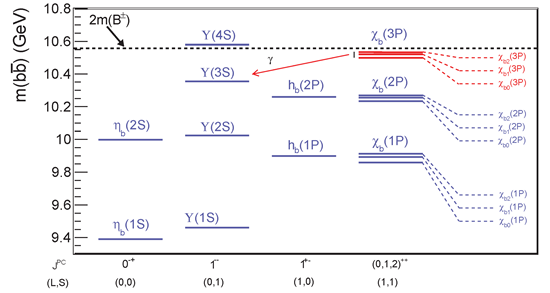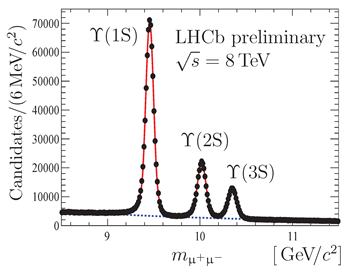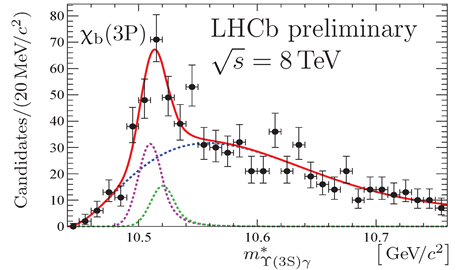Today at the 37th International Conference on High Energy Physics in Valencia, the LHCb collaboration has presented important results on the production of beauty-anti-beauty quark pair bound states called Upsilon mesons, ϒ, in proton-proton collisions at the Large Hadron Collider LHC. The LHCb results include a precise measurement of the mass of one of these states, and more excitingly reveal the striking observation that about 50% of Υ(3S) mesons observed in LHC collisions are in fact not produced directly, but they originate from the radiative decay of χb(3P) mesons.
The beauty-anti-beauty bound state ϒ was discovered in 1977 at Fermilab near Chicago. Just like ordinary atoms bound by the electromagnetic force, the beauty and anti-beauty quarks, bound by the strong force, form different quantum states with different angular momenta and different spin orientations as discussed in the 6 September 2010 news. This atom-like system is called beauty quarkonium (or bottomium).
The different S quantum states (ϒ(1S), ϒ(2S), ϒ(3S)) have beauty quark and anti-quark spins aligned and no angular momentum L giving the total spin J=S=1. On the other hand the P states (χb(1P), χb(2P), χb(3P)) have angular momentum L=1. The χb(3P) state was recently observed by the Atlas and D0 collaborations. Today, the LHCb collaboration has presented the most precise measurement of its mass so far to be performed, and obtained the result 10511.3 ± 1.7 ± 2.4 MeV/c2 (χb1(3P) mass for experts). The dotted red arrow labelled with “γ” indicates a possible decay path of the χb(3P): it may decay into a photon γ and an ϒ(3S) state. Similar transitions are possible to the ϒ(2S) and ϒ(1S) states.
The signal peaks coming from the S states decaying into muon pairs are shown in the left image below. The different states, ϒ(1S) , ϒ(2S) and , ϒ(3S) are very well separated thanks to the excellent resolution of the LHCb detector. LHCb physicists have then calculated the invariant mass of different ϒ states with different photons γ in order to find out if the ϒ(1S), ϒ(2S), ϒ(3S) states originate from the decay of different χb states, or not. This analysis showed that about 50% of the observed ϒ(1S) and ϒ(2S) states indeed come from the radiative decay of the χb particles, as many theorists had predicted. It was, however, generally assumed that the ϒ(3S) mesons were produced directly. Today’s LHCb results show, however, that, in fact, also about 50% of the observed ϒ(3S) mesons are not produced directly but they originate from the χb(3P) radiative decay as shown by the presence of the χb(3P) peak in the right image below.
click the images for higher resolution
Theoretical physicists will need to take into account the new LHCb results in their calculation of bottomium states production in proton-proton collisions at the LHC. The differences in the rates of production of different ϒ states in proton-proton and lead-lead collisions at the LHC have been interpreted as possible evidence for the formation of quark-gluon plasma in lead-lead collision. This interpretation will now have to be reassessed, taking account of the new LHCb results.
Read more in the LHCb conference presentation and in the LHCb publication.



